The Fiber Connect 2023 highlights reel includes insights from different leaders in the field:
Fiber Connect 2023
BTW, for those at the show who heard about the launch of our New Middle Mile report, you can download it here — and check out relevant videos too.
UNLOCKED REPORT — no personal info needed to download
“The middle mile holds a unique position in communications infrastructure – a Goldilocks zone balancing economies of scale and proximity.
Content from Sponsors and Thought Leaders
The following media comprises interviews and other content related to Fiber Connect 2023. Views expressed are those of the presenting individuals and companies and may not necessarily represent views of Converge! Network Digest or AvidThink.
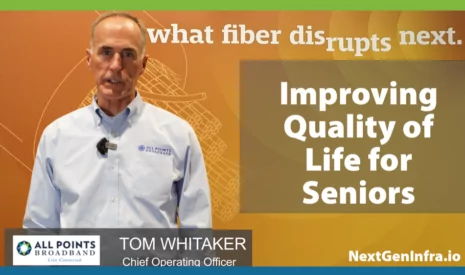
Improving Quality of Life for Seniors
Thomas Whitaker, the Chief Operating Officer at All Points Broadband, revealed the company’s ongoing project to provide broadband services to around 120,000 unserved homes in 23 rural Virginia counties. Whitaker anticipates that the introduction of fiber will enhance the quality of life for aging Americans, especially the Baby Boomer generation, by enabling them to age comfortably at home with the support of advanced technology.

Fiber is the Enabler for all Things Disruptive
Greg McLaughlin, CEO of Automation Exchange (AEX), at Fiber Connect 2023, emphasized that fiber networks will disrupt economic models and businesses, enabling smaller companies to operate fiber networks due to increased funding and automation technologies. McLaughlin predicts a significant transformation in the fiber business landscape over the next three years, with diverse groups entering the industry and providing services to their communities.
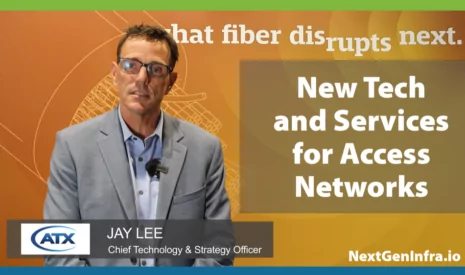
New Tech and Services for Access Networks
Jay Lee, Chief Technology and Strategy Officer at ATX Networks, discussed the company’s new super capacitor technology for improved energy storage in broadband networks and the launch of a fiber services organization to tackle the impending broadband industry shortage. Lee also emphasized the disruptive potential of fiber as the preferred platform for new builds and its role in the development of DOCSIS 4.0 technology, enabling cable operators to offer fiber-like services within their existing HFC networks.
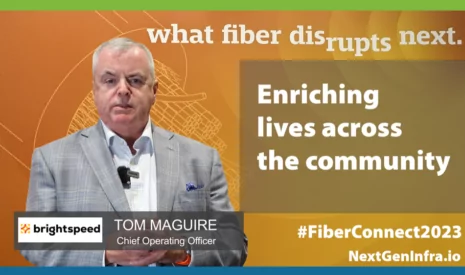
Enriching lives across the community
Tom Maguire, COO of Brightspeed, emphasized the transformative potential of fiber broadband connectivity for remote, rural communities, particularly for older individuals who may feel isolated. He underscored the ability of this technology to enhance their lives by facilitating communication with loved ones, access to telehealth and online shopping, and enriching their daily experiences beyond traditional financial, educational, or medical benefits.
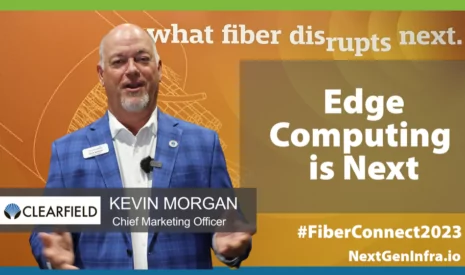
Edge Computing is the next Disruption
Kevin Morgan, Chief Marketing Officer at Clearfield, addressed Fiber Connect 2023, predicting that the next industry disruption will be in edge computing due to fiber technology’s ability to push data center functions closer to end users. Morgan highlighted that the expansion of fiber networks, driven by increased investment, will facilitate home and business services for gigabit and 10 gigabit services, as well as the aggregation of high capacity links from various devices, with fiber’s capacity to meet lower latency requirements being the next significant disruption.
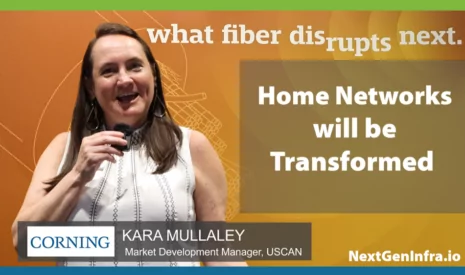
Unleashing Home Tech Potential with Fiber Advancements
Kara Mullaley, Market Development Manager for Carrier Networks at Corning Optical Communications, forecasts that the enhanced bandwidth from fiber technology will allow homeowners to utilize previously inaccessible technologies such as AI, virtual and augmented reality, and sustainability efforts. Mullaley asserts that the improved efficiency in information collection and distribution will result in superior decision-making for individuals, communities, and workplaces.
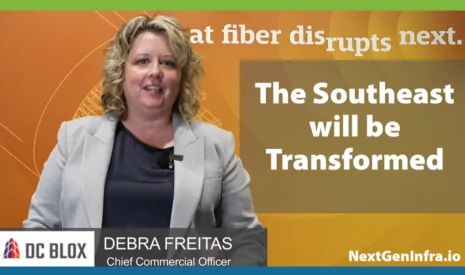
The Southeast Will Be Transformed by Fiber
Debra Freitas, Chief Commercial Officer at DC Blox, predicts that fiber technology will revolutionize the Southeast region, particularly through a cable landing station in Myrtle Beach that links to Atlanta, a significant connectivity hub. DC Blox anticipates this development to foster a new ecosystem, providing access to underserved and non-served communities in the region.
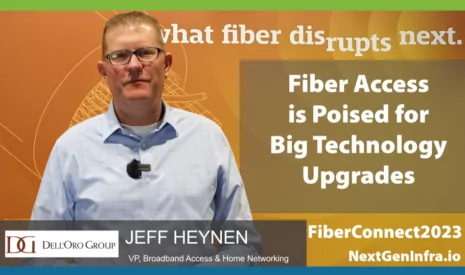
Fiber Access is Poised for Big Upgrades
Jeff Heynen, Vice President of Broadband Access and Home Networking Research for Dell’Oro Group, discussed the upcoming waves of innovation for fiber broadband, highlighting the transition from GPON to XGS-PON in the U.S. residential market. He also mentioned the ongoing work on 50 gig deployments in China and future developments including symmetric 50 gig options and 100 gig, emphasizing the limitless capabilities of fiber optics and predicting a rapid evolution of technologies for residential and enterprise deployments.
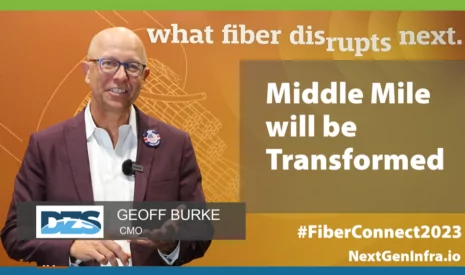
The Middle Mile will be Transformed
Geoff Burke, Chief Marketing Officer at DZS, spoke at #FiberConnect2023 about the impending disruption of the ‘middle mile’ in the network by widespread fiber access rollouts. Burke emphasized the potential of using coherent optics and DWDM to move bandwidth closer to the subscriber edge, and the opportunities this presents for creating a more robust infrastructure and adding new services to communities, thereby raising the bar for communication networks across North America and beyond.
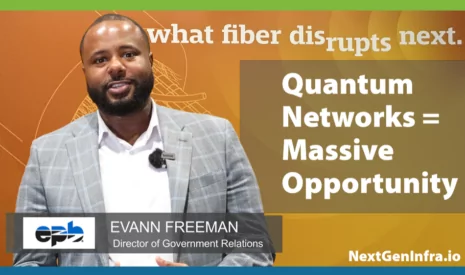
Quantum Networks are a Massive Opportunity
Evann Freeman, Director of Government Relations at EPB, revealed the company’s plan to construct the first commercially available quantum network in the U.S, a move inspired by a McKinsey study forecasting quantum to be a $106 billion industry by the decade’s end. The network, which could potentially revolutionize technology and create generational wealth, is designed to stimulate private investment and growth, enhance national security, and benefit businesses and industries in the Chattanooga area, with the potential for nationwide replication.

Accelerating Federal Permits for Broadband Access
Eric Beightel, Executive Director of the Federal Permitting Improvement Steering Council, predicts that fiber technology will revolutionize the federal permitting process, particularly for projects funded through the NTIA’s Broadband Middle Mile and Digital Inclusion programs. Beightel is keen to partner with the Fiber Broadband Association and its members to accelerate rollout.
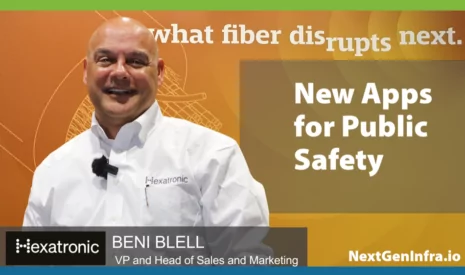
New Applications for Public Safety
Beni Blell, VP and Head of Sales and Marketing at Hexatronic, discussed the disruptive potential of fiber optics in various industries, highlighting innovative applications like distance learning, telehealth, and enhanced neighborhood safety through fiber-empowered applications such as crime-monitoring drones. Blell anticipates the development of many more such applications in the future.

Fiber's Impact Extends Across the Community
Earnie Holtrey, Deputy Director of the Indiana Broadband Office, emphasized the importance of fiber connectivity in sectors like agriculture, remote work, education, and telemedicine at the Fiber Broadband Association 2023. He also highlighted the potential of fiber technology to support emerging technologies like chat GPT and AI, underscoring the need for quality connectivity for equitable access to these advancements.

Coherent Optics will Redefine Access and Edge
Fady Masoud, Senior Director of Solutions Marketing at Infinera, spoke at Fiber Connect 2023 about the disruption of access and edge networks by fiber, showcasing a proof of concept with Infinera’s ICE-X intelligent coherent optics that extends coherent capacity and reach 40 times the capacity and 10 times the reach over existing PON infrastructure. This technology allows high-speed business services to be overlaid over existing infrastructure, maximizing ROI, opening new revenue streams, and providing a competitive edge, with Infinera currently conducting global field trials.
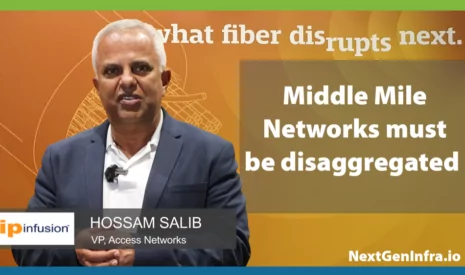
Disrupting the Middle Mile with Disaggregated Fiber Solutions
Hossam Salib, VP Sales, Americas at IP Infusion, emphasized the potential of fiber to revolutionize the ‘middle mile’ connection and the challenges of traffic aggregation and transportation from fiber to various locations. Salib proposed a flexible, disaggregated solution that allows carriers to select optimal software and hardware solutions, which could significantly cut costs and ease the transition to ubiquitous fiber.
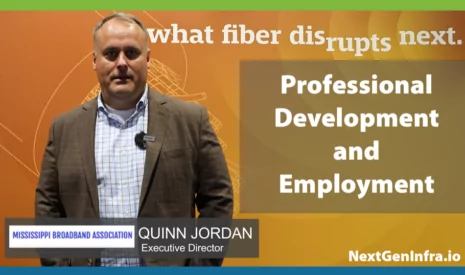
Fiber's Potential for Workforce Advancement
Quinn Jordan, Executive Director of the Mississippi Broadband Association, discussed the transformative potential of fiber networks in Mississippi at the Fiber Broadband Association’s fall conference, emphasizing its impact on workforce development and job creation, particularly in the South. Jordan underscored the importance of online training and cooperative efforts in preparing individuals for new roles in the fiber industry, concluding that fiber will be a significant disruptor in the near future.
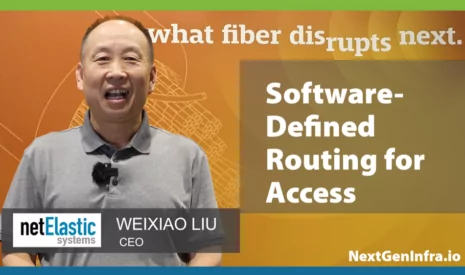
Software-defined Routing for Access Networks
Weixiao Liu, CEO of NetElastic, predicts that fiber will disrupt hardware-based routers, especially access routers, and advocates for software-defined routing solutions like vbng and CGN routers. Liu asserts that these software-defined routers, which run on commodity hardware and offer cost-effective scalability, are the optimal choice to meet the increasing demand for servers and bandwidth in the Access Network.
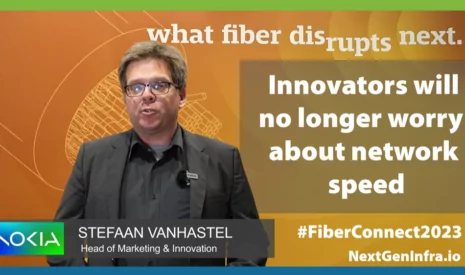
Innovators will no longer worry about network speed
Stefaan Vanhastel, Head of Marketing & Innovation at Nokia, emphasized the transformative potential of fiber in connecting everyone and everything, transforming business operations, and enabling high-speed innovation. He highlighted the role of fiber in providing access to essential services like e-health and e-learning, enhancing business efficiency, and facilitating the generation of innovative ideas due to its high speed of up to 25 gigabits per second and beyond.
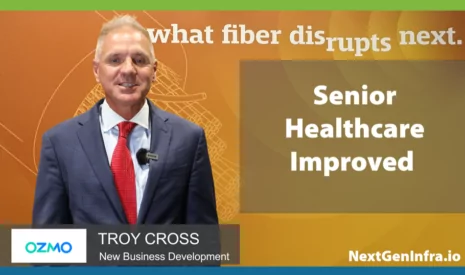
Transforming Senior Home Healthcare with Fiber
Troy Cross from OZMO highlighted the potential of fiber technology to revolutionize senior home healthcare, citing remote monitoring capabilities, rapid emergency responses, enhanced telemedicine efficacy, access to health information, and reliable video connections for social interaction as key reasons. He emphasized that this technology can empower seniors to take control of their health and prevent isolation.
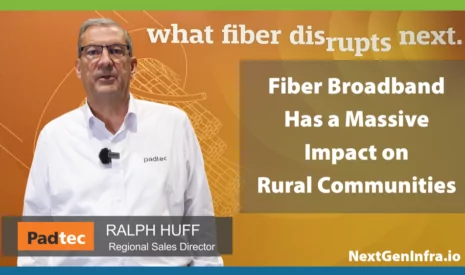
Fiber Broadband has a Massive Impact on Rural Communities
Ralph Huff, the Regional Sales Director for Padtec, predicts that rural communities and farms will be the next areas disrupted by fiber technology, enabling precision agriculture and facilitating data upload for improved crop yield analysis. Huff also anticipates the emergence of new markets, potential for remote work, and significant developments as fiber technology expands into rural areas.
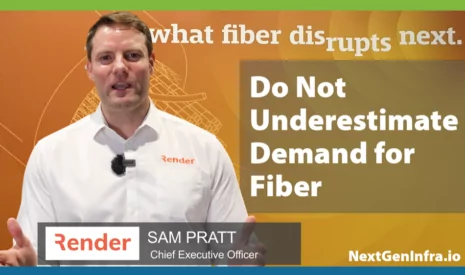
Do Not Underestimate Demand for Fiber Broadband
Sam Pratt, CEO of Render Networks, addressed Fiber Connect 2023, discussing the disruptive potential of fiber in sectors like AI, connected communities, and rural education, and highlighting the increasing demand for fiber and the readiness of its supply. Pratt emphasized the importance of technology in construction management projects and the role of geospatial data in enhancing customer connection experiences and delivering top-tier connectivity.

Finding the Killer App for Fiber Broadband
Alain Meller, the Deputy CEO of Setics, emphasized the transformative impact of high-speed fiber connectivity on people’s lives, including remote work, simultaneous content streaming, and numerous connected devices in the home. Meller concluded that the future is led by fiber connectivity, indicating its disruptive potential is already present but not yet fully realized by all.
Fiber Deployment Models are getting Disrupted
Brant Carter, Director of Telecom at SiteTracker, addressed the potential of fiber to revolutionize network deployment and construction at Fiber Connect, highlighting the inefficiency of traditional methods in the future. Carter emphasized the opportunity to enhance collaboration and digitally connect field to office, facilitated by SiteTracker’s cloud software application that assists in planning, deploying, and maintaining networks.
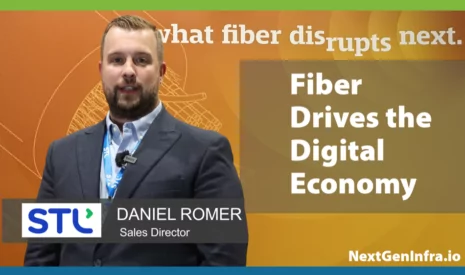
Fiber Broadband Drives the Digital Economy
Daniel Romer, Sales Director at STL, predicts that fiber-based broadband will revolutionize the digital economy in the U.S., supporting remote work, online learning, and skill monetization from any location. Over the next five years, STL aims to extend broadband networks across the country, including rural areas, to provide reliable and consistent broadband connections with equal upload and download speeds for all.
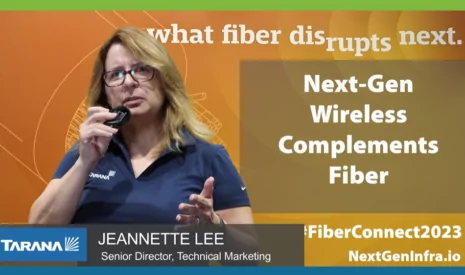
Next-Gen Wireless as a Complement to Fiber Broadband
Jeanette Lee, Senior Director of Technical Marketing at Tarana, highlighted the potential of wireless technology in improving the reach and efficiency of fiber operators. Lee suggested that integrating wireless with fiber can help operators expand coverage, increase subscribers, deliver applications faster, and expedite the realization of fiber applications, particularly when combined with next-generation wireless technology.
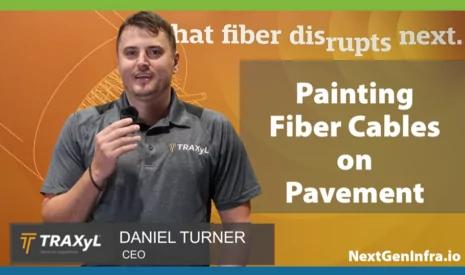
Painting Fiber Cables on Payment
Daniel Turner, CEO of Traxyl, highlighted the company’s unique approach to fiber optic cable installation, which involves developing machines that can “paint” fiber optic cables directly onto pavement, thereby eliminating trenching. Turner believes this innovative method, aimed at providing fast, affordable connectivity to underserved locations, could significantly disrupt the fiber industry and contribute to economic growth.
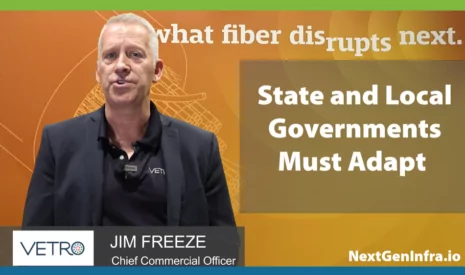
State and Local Government Must Adapt to Fiber Reality
Jim Freeze, Chief Revenue Officer at Vetro, predicts that state and local government will be the next sector disrupted by fiber technology due to their lack of comprehensive understanding of their fiber assets and connections. Freeze believes this disruption will lead to improved management and utilization of fiber assets within these government bodies.